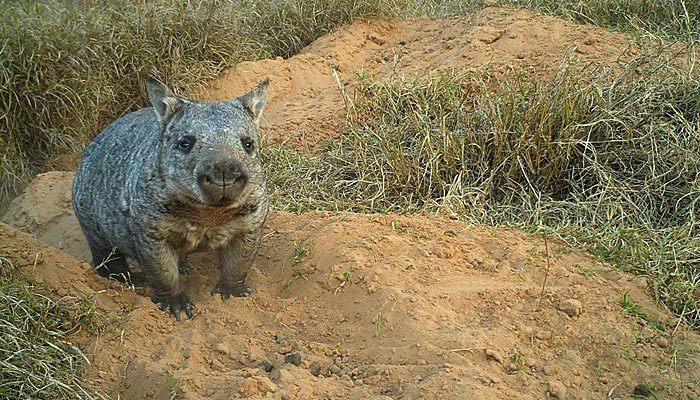Critically endangered wombats explore new home
Published Thursday, 06 June, 2024 at 04:15 PM
Minister for the Environment and the Great Barrier Reef and Minister for Science and Innovation
The Honourable Leanne Linard

- The first northern hairy-nosed wombats have been released into their new home at Powrunna State Forest near St George in south-west Queensland.
- Up to 60 wombats will be gradually translocated from Epping Forest National Park (Scientific) to Powrunna in the coming years.
- The critically endangered species of wombat has been brought back from the brink of extinction through the dedicated work of the Department of Environment, Science and Innovation.
In a magnificent moment for conservation, the first northern hairy-nosed wombats have been released to explore their new home at Powrunna State Forest near St George in south-west Queensland.
Northern hairy-nosed wombats are one of the rarest land mammals in the world.
The Department of Environment, Science and Innovation (DESI) is establishing a new population of the critically endangered species at Powrunna, after successfully growing the population at Epping Forest National Park (Scientific) near Clermont in Central Queensland and establishing a new population at Richard Underwood Nature Refuge, also near St George, in 2009.
The Epping Forest population recently reached a population milestone of 400 northern hairy-nosed wombats, while around 18 wombats currently live at Richard Underwood Nature Refuge.
Up to 60 wombats will be gradually translocated from Epping to the 2800-hectare Powrunna State Forest in the next two-to-three years in an effort to create a self-sustaining population.
DESI identified Powrunna as the location to establish the new population in 2023 following an analysis of potentially suitable sites.
As wombats dig vast burrows, they require a specific ratio of sand and clay in the soil to support their burrows and ensure they don’t collapse. The environment at Powrunna State Forest has these unique suitable soil characteristics.
The establishment of the third population at Powrunna is the result of a partnership between DESI, Gunggari Native Title Aboriginal Corporation (GNTAC) and Gunggari Native Title Holders, Glencore and The Wombat Foundation.
In preparation for the arrival of the wombats, DESI has installed predator-proof fencing around the forest, installed water infrastructure and remote cameras and dug starter burrows to ensure the wombats can immediately find cover.
Glencore has provided a long-term financial commitment to the recovery program, including $2.1m towards establishing the third population at Powrunna State Forest.
The Wombat Foundation have provided support for the program since 2004, including provision of the new-design transport boxes.
Quotes attributable to Minister for the Environment and the Great Barrier Reef and Minister and Science and Innovation, Leanne Linard:
“It is always a special day when you can say a species has been brought back from the brink of extinction.
“It is very exciting to see the first wombats to be translocated from Epping to Powrunna State Forest.
“The translocation program has taken years of meticulous planning by my department, and the wombats have a wonderful new home at Powrunna, which will help future-proof the population of this critically endangered species.
“It is amazing to see how far we have come given the population of wombats at Epping Forest dropped to around 35 in the 1980s, and I’d like to thank everyone who is helping to bring the northern hairy-nosed wombats back from the brink.
“Successes like this is why the Miles Government has committed $40 million to our Queensland Threatened Species Program.
“Our government is committed to the protection and recovery of species most at risk of extinction, and our record spend of $262.5 million will increase more environmentally and culturally significant land acquired for protection across the state in the years ahead.”
Quotes attributable to Wombat Foundation Director, Leanne Brosnan:
“The Wombat Foundation is very proud to be a key partner in the conservation of northern hairy-nosed wombats and in supporting the establishment of a third population of the species at Powrunna.
“The great work at Epping Forest National Park has seen the population grow from a small population of 35 animals to around 400 animals which is an amazing achievement and one that TWF is thrilled to have been part of.
“We are very excited to welcome the wombats to their new home at Powrunna and are looking forward to seeing them settle in to their new burrows and flourish at Powrunna.”
Quotes attributable to GNTAC and Gunggari Native Title Holders cultural heritage coordinator, Maud Kearns:
“Gunggari Native Title Aboriginal Corporation and Gunggari Native Title Holders have supported DESI in preparatory works at Powrunna State Forest.
“This support ranges from cultural heritage survey clearances, cultural heritage awareness training with staff and contractors working on the project and being part of the project management committee.
“This is a unique project to be involved with, and GNTAC and Gunggari Native Title Holders look forward to continuing our partnership and connection with Powrunna State Forest and DESI.”
Fast facts:
Fast facts on the northern hairy-nosed wombat:
- Northern hairy-nosed wombats are nocturnal and feed primarily on grass
- Their burrows maintain reasonably constant temperature and humidity
- Females give birth to one joey that remains in the pouch for around eight to nine months
- The northern hairy-nosed wombat is the largest burrowing mammal in the world, and is the largest of the three wombat species
The species has previously only been found in three locations. However, by 1982, northern hairy-nosed wombats were restricted to a single population at Epping Forest National Park (Scientific) in inland Central Queensland.
The population of northern hairy-nosed wombats at Epping Forest is currently 400 animals. A second colony of northern hairy-nosed wombats was established in 2009 at Richard Underwood Nature Refuge at Yarran Downs near St George in southern Queensland. The first northern hairy-nosed wombats were translocated to the site in July 2009, with additional wombats added in 2010.
ENDS
Media contact: Scott Chandler – (07) 3719 7339

